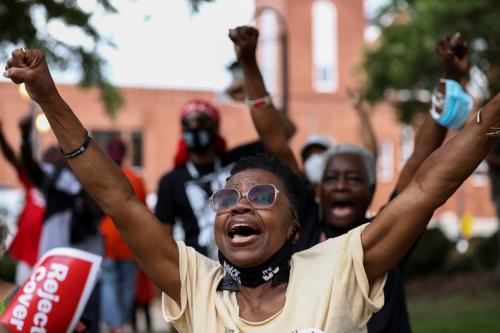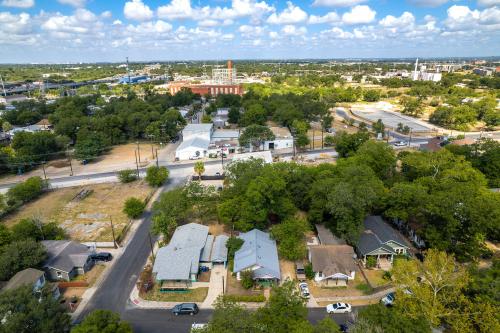In a nation grappling with a seemingly endless cycle of violent crime and police shootings, the public narrative often perpetuates a simplistic assumption: These issues are exclusively Black experiences. However, a closer examination of the data reveals a far more complex picture that challenges this oversimplified notion. In 2023, data on police shootings revealed a complex picture, with approximately 40% of civilians shot being white, 20% Black, 13% Hispanic, and three percent of other races; notably, the race/ethnicity of a significant portion—24%—of those shot by police in the same year was not reported, highlighting ongoing challenges in transparency and data collection surrounding these critical incidents.
In a report published in the same year, the victims of violent crime were 62% white, 12% Black, 17% Hispanic, and four percent Asian, American Indian, or Alaska Native. Furthermore, more recent data indicates that 53% of those arrested for violent crimes were white, while 25% were Black and 14% were Hispanic. These statistics highlight the importance of examining the intricate connections between race, socioeconomic factors, crime, and policing through a disaggregated lens. Our newly published study delves into these deeper issues, providing surprising and counterintuitive findings that challenge conventional assumptions and shed light on the roots of violent crime and police violence, as best understood through local analysis.
Drawing on data from 100 major U.S. cities, we analyzed a comprehensive set of factors, from economic indicators and educational outcomes to health metrics and demographic statistics. We scrutinized how each of these community-level factors intersected with violent crime and police shootings of civilians. The scope of this analysis allowed us to identify key variables and their relative impacts in a way often overlooked in academic and popular culture conversations. The results challenge long-held beliefs that have been firmly rooted in public discourse around these issues and, more deeply, within American culture.
We found that a higher percentage of Black residents within a city did not correlate with more violent crime once other variables were taken into consideration. These findings run counter to assumptions that are central to many policy debates and public conversations around crime, race, and policing. Instead, the primary drivers pertained to socioeconomic disadvantages, such as income inequality, lack of quality education, food insecurity, and strained mental health services. These factors demonstrated connections to elevated violent crime levels and more frequent police shootings of civilians. Factors like neighborhood-level poverty, barriers to health care access, and concentrations of other criminogenic variables appear to create conditions that enable both violence and police shootings. Criminogenic factors refer to conditions or characteristics associated with an increased likelihood of criminal behavior, such as high unemployment rates, low educational attainment, and a lack of community resources and/or support systems. These findings do not absolve America’s long, painful history of racism and its modern repercussions. Rather, the legacy of discriminatory policies and practices has inevitably left Black and other underserved communities disproportionately impacted by the very socioeconomic disadvantages examined in our study.
Research on the relationship between violent crime rates and police killings makes it clear that context matters. Our analysis extends this examination by utilizing local data from 100 cities across the United States. We found that police shootings were associated with local violent crime rates, even when accounting for other community factors such as mental health concerns and food insecurity. However, correlation does not necessarily imply causation. Higher rates of both violent crime and police shootings may stem from shared systemic issues rather than from directly impacting each other. Moreover, local dynamics can differ substantially from national trends, underscoring the importance of context-specific analyses.
It is important to emphasize that our findings do not argue that the socioeconomic factors we examined directly lead to racial disparities in police violence. Rather, taking a closer look, class-based factors appear to play a larger role than race in predicting both violent crime and police shootings. However, this does not negate the reality of racial bias and systemic racism, which likely contribute to these outcomes even if not detectable with our methodological approach. Our goal was to identify actionable solutions that can reduce harm, not to dismiss the reality of race as it plays out in communities across this country. Future research must further examine the complex interactions between class and race, such as comparing the responses to race in low vs. high poverty communities.
Our approach of disaggregating multiple community factors differs from other studies, which find racial disparities in police violence when examining race alone without accounting for socioeconomic context. By separating these factors, we aim to provide a more nuanced understanding of the local dynamics that contribute to both violent crime and police killings, which can inform the development of effective, community-specific interventions. We call for more research using this type of multifactored, community-level analysis to better understand and address these complex issues.
It could be argued that by controlling for socioeconomic factors, we are simply explaining away the relationship between violent crime, police shootings and a person’s racial classification, and that race would be a significant predictor if these factors were not present. However, our response is twofold. First, it is recognized that race and socioeconomic status are deeply intertwined due to historical and ongoing systemic racism. Poverty, lack of access to education, and other disparities that we controlled for are not randomly distributed across racial groups. Therefore, controlling for these factors does not negate the role of race; rather, it helps to identify the specific mechanisms through which racial disparities may operate. In effect, we are disentangling what Isabel Wilkerson describes in ”Caste: The Origins of Our Discontents” and what Heather McGhee illustrates in “The Sum of Us”—the way systemic racism has created a society where race and class are structurally commingled, with communities of color disproportionately experiencing the socioeconomic disadvantages that our data suggests drive crime and police shootings.
Second, our findings suggest that when we examine socioeconomic factors at the community level, race does not emerge as a significant predictor of violent crime or police shootings. This does not mean that race is unimportant, but rather that the effects of race may be largely mediated through these socioeconomic conditions. It is more common that examinations of racial disparities fail to tease out the underlying factors to the same extent as we do in our analysis. By doing so, we sought to provide a more nuanced understanding of how race intersects with other forms of disadvantage, ultimately shaping community-level outcomes.
In the end, our goal was not to dismiss the role of race, but to better understand the specific pathways through which racial disparities emerge and to guide interventions that can effectively address the root causes of these disparities. Future research should continue to examine the complex relationships between race, socioeconomic conditions, and community outcomes to inform equitable policies, programming, and practices.
Potential explanations
Based on our findings, there are a few potential explanations for why factors like poverty, poor education, food insecurity, and mental health challenges appear to drive violent crime and police shootings more so than race itself:
- Systemic disadvantages: Centuries of systemic racism have resulted in many disenfranchised communities facing entrenched socioeconomic disadvantages, including underfunded schools, neighborhood poverty, environmental inequality, and lack of access to mental health resources. These deprivations lead to societal stresses that strip away stability and opportunity. Such concentrated disadvantages faced by communities over generations creates conditions that enable violence, crime, and hostile policing. The compounding effects ultimately manifest in the types of negative outcomes our research reflects.
- Environmental influences: Decades of research have shown our environments and surroundings shape behavior and attitudes over time, especially for young people. Children growing up in high-crime areas essentially become acculturated to volatility, instability, and antisocial norms as the status quo from an early age. Chronic poverty, hunger, lack of positive role models, and weak community institutions are factors that coalesce to influence values and life trajectories in ways that can promote violence as an adapted coping mechanism or economic necessity. Similarly, police officers deployed for years in high-crime neighborhoods and exposed repeatedly to stressful situations develop mindsets that may perceive even ambiguous civilian behavior as an imminent threat, making excessive use of force more likely.
- Criminogenic factors: Poverty, low educational attainment, untreated mental illness, and family instability are all recognized factors that increase an individual’s likelihood of engaging in criminal behavior. Communities heavily impacted by concentrations of these criminogenic forces will inevitably experience higher rates of offending until those root causes are addressed in a systematic, sustained manner. Race is not a criminogenic root cause but rather a label that helps better understand the cyclical, inequitable effects of institutional discrimination and the impact of being raised in environments starved of the developmental resources and stabilizing forces that allow people to succeed.
Why all of this matters
The data from our study suggests it is time we extend beyond oversimplified narratives around race and refocus efforts upstream on the intersectional, systemic, racial, and socioeconomic disadvantages that enable community violence and sow seeds of mistrust between police and the citizens they serve. While our findings indicate that factors like poverty, lack of education, and inaccessible mental health services are among the most robust aggravating factors, it would be misguided to interpret these results as suggesting that race is irrelevant or unimportant in these dynamics. The reality is that race and class are inextricably intertwined in America, with the Black community historically and presently disproportionately impacted by the very socioeconomic inequalities highlighted as drivers of crime and police shootings in our analysis.
In the current political climate, it must be noted that many Black communities across the United States do not experience high levels of crime, demonstrating that race alone is not the determining factor. For example, View Park–Windsor Hills, Baldwin Hills, and Ladera Heights in Los Angeles County; Mitchellville and Woodmore in Prince George’s County, Maryland; Harlem in New York City, Olympia Fields, Illinois, and several communities in Houston, Texas are all thriving Black neighborhoods with low crime rates. These communities often benefit from higher levels of education, employment, and community resources, which our findings suggest are protective factors against crime and police shootings. By highlighting these examples, we aim to challenge the notion that Black communities are inherently prone to crime and instead emphasize the importance of addressing the underlying socioeconomic inequities that disproportionately affect many poor communities.
The centuries-long legacy of systemic racism through discriminatory policies and practices has created an environment where Black populations are overly concentrated in high-poverty, under-resourced areas with inadequate access to quality education, health care, economic opportunities, and other stabilizing forces. It is this confluence of compounding racial and socioeconomic inequalities that appears to cultivate the cycles of community violence and hostile police-citizen relationships which continue to plague many disenfranchised neighborhoods. Our findings do not negate the need to double-down efforts rooting out racist ideologies, practices, and individual biases that still exist in policing and society at large. However, they do suggest that we also must directly attack these crises through a socioeconomic and public policy lens focused on finally righting the intergenerational wrongs and opportunity gaps produced by structural discrimination.
The path forward is clear, but it will require a radical reckoning with the historical and ongoing legacy of racial oppression that has shaped the socioeconomic conditions of Black communities. The crisis of crime and police violence is rooted in centuries of economic exploitation, political disenfranchisement, and the psychological impact of systemic racism. Addressing these issues will require a fundamental restructuring of the systems that have perpetuated racial inequality, while also prioritizing the mental health needs of Black communities and providing culturally competent care that addresses the traumas of racism. Moreover, closing the racial wealth gap through measures such as reparations must be a central priority in any effort to address the root causes of crime and police violence.
Only by confronting these intersecting forms of oppression—economic, political, psychological, and social—through bold, comprehensive initiatives that eradicate deep-rooted inequalities—in income, education, community investment, health care, and food security—can we hope to create the conditions for lasting, transformative change. The time has come for a holistic, intersectional approach to policymaking that recognizes the complex interplay between race and class. Let us seize this moment to champion equity, justice, and opportunity, and in so doing, build a society where every individual, regardless of race or zip code, can thrive in safety and peace.





Commentary
Rethinking the role of race in crime and police violence
June 27, 2024